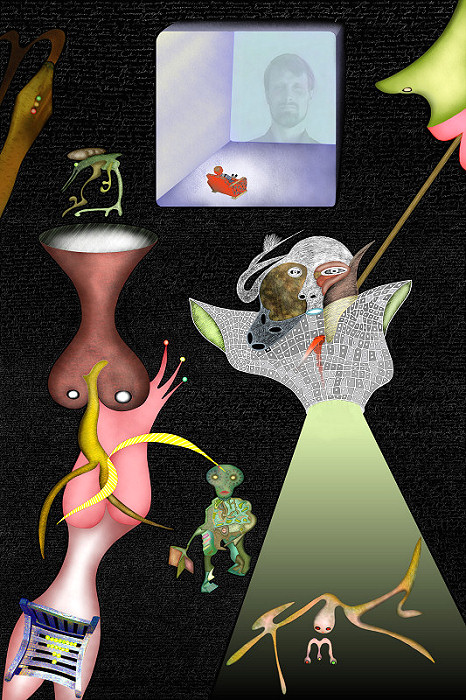
“Nocturno”
"Nocturno" was created Aug. - Oct. 2007 with
"Painter"(Metacreations), partially
(less than 5%) using digital photo material.
Print: Piezo-Print on DFA-paper Size: Paper: 112x76 cm, Picture: 84x56 cm Copies: 25, numbered and signed, and 5 artist's copies (I-V) Price: 900.‒ Euros Artist: Björn Dämpfling
“Nocturno” is a phantasmagoric example, what separates art from
real life. It’s an utterly personal image, telling every onlooker
another story, even better though, other stories. I am so sure about
that, because I myself see only fragments, parts of the image that
have a personal, contextual meaning for me, going by as if mounted on
a merry-go-round, without giving any real clue what to think about
them, no final thoughts at all. Nothing could make me happier,
because it proves that this image is anything but an “illustration”
or “visualization” of individual feelings. If the visual, as in this
case, has a narrative structure, then it should be an enigma having
an indefinite number of solutions and that’s how this image works for
me. In technical terms it is really a digital image, combining manual
drawing done with the PC, software generated color gradients and
manipulated photography, all embedded in a truly handwritten text
done with the PC of course. Despite the fact that this text was
partially meaningful, it is nothing but a visual structure concerning
this image (you can only read the hints that one should not be trying
to read, because it is useless, since everything meaningful can not
be deciphered), it is what bonds the elements, neither just
background nor swallowing them. When at first all those figures stood
before a purely black background, they conveyed an impressive look,
but a whole “dimension” seemed to be lacking, a fact I felt was a
problem for which I had for quite some time no solution at hand. It
happened when I saw by chance my image “Waldschriftstück”, which also
employs handwriting as a visual structure that I got the idea to try
this again, and it looked great, because the white script flooded the
image producing a visual effect as strong as the one when all the
figures were standing before the pure black, but now kind of
“swallowing” them, taking away a part of their necessary tension. In
order to counter this, I covered the white script with a touch of
digital aquarelle colors, lessening the white and having it fade
progressively to the bottom until the script seems to be totally
gone. That way I got the perfect visual dramaturgy for my taste, and
every time I see it, another—a “new” image.

